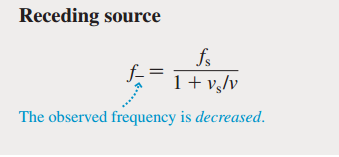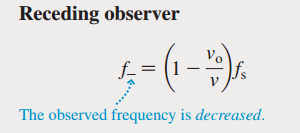The Doppler effect and Standing Waves
1/25
There's no tags or description
Looks like no tags are added yet.
Name | Mastery | Learn | Test | Matching | Spaced |
|---|
No study sessions yet.
26 Terms
What is the droppler effect?
The droppler effect is seen when the source( object, thing, person, etc that is causing the disturbance (waves) moves)
The droppler effect is the apparent change in the frequency of a wave caused by the relative motion between the source of the wave and the observer.
So, all in all, the doppler effect is a change in frequency interpreted by the observer due to the relative motion between the source and observer.
When the source is moving towards the observer, the sound(or whatever wave) is delivered at a ____________ frequency.
higher ( higher pitch- for sound waves)
When the source is moving away form the observer, the sound(or whatever wave) is delivered at a ____________ frequency
lower( for sound - lower pitch)
Who was the droppler effect described by?
The droppler effect was first describe in 1842 by Austian physicist Christian Doppler.
Why does the frequency increase when the source is approaching the observer? (In relation to the Doppler effect)
In understanding this we can look at the velocity equation for waves V = fλ
Based on this equation, when can see that frequency and wavelength are inversely proportional.
When the source is moving towards the observer, the waves are compressed(compression).
Thus, the wavelength is smaller, so the frequency is greater.
The velocity of the sound waves remain the same because it depends on the medium not the distance.
Why does the frequency decrease when the source is moving away from the observer? ( In relation to the Doppler effect)
In understanding this we can look at the velocity equation for waves V = fλ
Based on this equation, when can see that frequency and wavelength are inversely proportional.
When the source is moving towards the observer, the waves are further apart (rarefaction).
Thus, the wavelength is larger, so the frequency is less.
The velocity of the sound waves remain the same because it depends on the medium not the distance
When there is no relation motion between the source of the waves and the observer, like it they are both stationary, does the doppler effect still occur?
No
The Doppler Effect is all about relative motion. It only happens when either:
The source is moving toward or away from the observer,
The observer is moving toward or away from the source,
Or both are moving with respect to each other.
Doppler effect formula ( stationary observer approaching source)

Doppler effect formula ( stationary observer receding source)

Doppler effect formula ( stationary source approaching observer )

Doppler effect formula ( stationary source receding observer )

What does the principle of Superposition state?
If two or more traveling waves are moving through a medium and combine at a given point, the resultant position of the element of the medium at that point is the sum of positions due to the individual waves.
Linear waves
Waves that obey the superposition principle are called linear waves. (Generally, linear waves have amplitudes smaller than their wavelengths
What happens when two waves are traveling in the same direction with the same magnitude?
Unlike objects, waves can occupy the same space at the same time.
Therefore, waves no not collide when approaching each other instead they interfere via superposition.
Constructive Interference
Where two waves collide as a result of superposition and it result in an addition of the amplitude( greater wave pulse)
This usually happens when the waves are traveling in the same direction
Destructive Interference
The waves travel in opposite directions, thus, the wave pulses cancel each other out when the two waves occupy the same space.
When the wave has the same shape and amplitude but are on opposite sides. ( Total destructive interference- the two waves need to be perfect inversed of each other)
What are a standing waves?
Standing waves are waves that appear to be “Standing still” rather than traveling through a medium.
They form when two waves have the same frequency and amplitude but travel in opposite directions and interfere with each other.
Instead of moving left or right, the waves seem to just vibrate up and down in place.
each end of standing waves are nodes.
Nodes
Location of total destructive Interference
These points are stationary
Antinodes
Constructive Interference creates the largest amplitude
Points are in motion
Why do standing waves occur?
Standing waves occur due to constructive and destructive interference between two waves moving in opposite directions.
Standing Waves only occur at certain frequencies
Standing waves usually happens when a waves reflects back on itself.
What causes standing waves to occur?
Reflection
Superposition
Resonance
Why do standing waves only occur at certain frequencies?
Because the wave has to fit perfectly in the space (like a loop or half-loop on a string), only specific wavelengths—and therefore specific frequencies—will work.
These "just right" frequencies are called resonant frequencies or natural frequencies. At other frequencies, the interference isn't stable, so no standing wave forms.
How does standing waves relate to resonance?
🌀 Standing waves form when a wave reflects and interferes with itself in just the right way—certain points stay still (nodes), and others vibrate a lot (antinodes).
🔊 Resonance happens when a system (like a string, air column, or tuning fork) is driven at one of its natural frequencies—a frequency at which it "likes" to vibrate. When this happens, the system responds with maximum amplitude.
🎯 So what's the connection?
Standing waves only form at resonant frequencies.
When a system is driven at a resonant frequency, the wave fits perfectly into the length of the system, creating constructive interference that builds up into a standing wave.
That’s why resonance causes standing waves, and standing waves are a visual and physical sign of resonance.
Are boundaries needed to cause standing waves?
Yes—boundaries are essential for standing waves to form. Without boundaries, you won't get the kind of reflection and interference needed to create a standing wave pattern.
📌 Why are boundaries needed?
Standing waves happen when:
A wave travels through a medium.
It hits a boundary (like the end of a string or a wall).
It reflects back.
The reflected wave interferes with the incoming wave.
If the conditions are right (like frequency and length), a standing wave forms.
⚠ No boundary = no reflection = no standing wave
If there's no boundary, the wave just keeps traveling and doesn't reflect back to interfere with itself. That means:
No constructive/destructive interference pattern
No nodes or antinodes
Just a traveling wave, not a standing one
What counts as a boundary?
🧱 What counts as a boundary?
Fixed end of a string (like a guitar string)
Closed or open ends of a pipe (in wind instruments)
Surfaces in a room (where sound waves reflect)
Even things like walls in a tube or container
These boundaries cause reflection, which is crucial for creating the interference that produces standing waves.
What is beat?
A beat occurs when two waves of slightly different frequencies interfere. This results in a periodic loud- soft modulation of intensity( amplitude